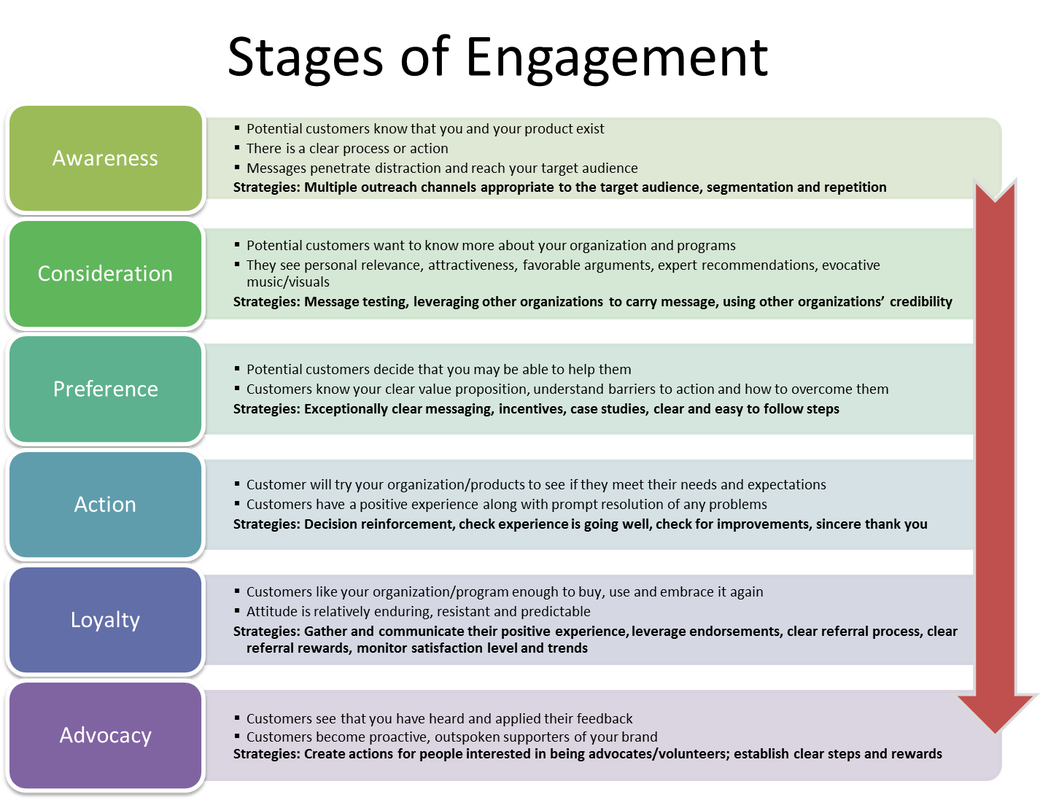Engaging Current and Potential Residents
|
Developing participation, engagement and behavior change can be frustrating. That frustration often comes out as “We’ve tried that!”
Unfortunately, building participation and engagement is more than creating a cool event and listing it on a website. There are deliberate, disciplined steps to take a cool event and turn it into a successful event. Here are two actionable models to help in this process.
In traditional marketing, organizations seeking to influence attitudes or drive a specific behavior to consider their strategy through four lenses in the model below: product, place, price and promotion. All organizations need to articulate answers to each of the questions below to get the behavioral outcome they want, regardless of whether it’s attending a festival, volunteering, or choosing your community as a place to call home.
Unfortunately, building participation and engagement is more than creating a cool event and listing it on a website. There are deliberate, disciplined steps to take a cool event and turn it into a successful event. Here are two actionable models to help in this process.
In traditional marketing, organizations seeking to influence attitudes or drive a specific behavior to consider their strategy through four lenses in the model below: product, place, price and promotion. All organizations need to articulate answers to each of the questions below to get the behavioral outcome they want, regardless of whether it’s attending a festival, volunteering, or choosing your community as a place to call home.
A helpful tool to assist in answering the questions above is the stages of engagement model. This model is especially helpful in the promotional phase of outreach.
A helpful tool to assist in answering the questions above is the stages of engagement model. This model is especially helpful in the promotional phase of outreach.
Public outreach and education is frequently a weakness in organizations that have a wide range of programs, services and stakeholders. The reason is that such organizations perceive a communication message as a task. Once communicated in a newsletter or a board meeting, the task can be checked off. The organization can move on to the other tasks on its to-do list.
Communication should be a system that is supported by deliberate messages at specific times through multiple types of media. The point at which organizational leaders feel the message has been repeated until they are sick of it is the point at which their target audience is becoming aware that there might be a message. The saying “you need to repeat a message 7 times for people to get it” is inaccurate.
When it comes to communicating high-priority messages, organizations must not only “beat the dead horse,” but they must beat it deliberately until it is glue ̶ leveraging multiple communication modes, multiple repetitions, and ideally multiple allied organizations sharing the message as well. Then organizations should measure awareness and the volume of desired actions to know if progress is happening and where further improvement is needed.
For more information, visit the Cobalt website or reach out to us by email. Let us know if you need anything at all for benchmarking or research data; we are here for you.
Cobalt Community Research is a national 501c3 nonprofit, non-partisan coalition that helps local governments, schools and membership organizations affordably engage communities through high-quality surveys, dynamic population segmentation, focus groups and work groups that use instant audience feedback technology. Cobalt combines big data with local insights to help you thrive as changes emerge in the economic, demographic and social landscape. Explore how we can help you by calling 877.888.0209, or by emailing [email protected].
Communication should be a system that is supported by deliberate messages at specific times through multiple types of media. The point at which organizational leaders feel the message has been repeated until they are sick of it is the point at which their target audience is becoming aware that there might be a message. The saying “you need to repeat a message 7 times for people to get it” is inaccurate.
When it comes to communicating high-priority messages, organizations must not only “beat the dead horse,” but they must beat it deliberately until it is glue ̶ leveraging multiple communication modes, multiple repetitions, and ideally multiple allied organizations sharing the message as well. Then organizations should measure awareness and the volume of desired actions to know if progress is happening and where further improvement is needed.
For more information, visit the Cobalt website or reach out to us by email. Let us know if you need anything at all for benchmarking or research data; we are here for you.
Cobalt Community Research is a national 501c3 nonprofit, non-partisan coalition that helps local governments, schools and membership organizations affordably engage communities through high-quality surveys, dynamic population segmentation, focus groups and work groups that use instant audience feedback technology. Cobalt combines big data with local insights to help you thrive as changes emerge in the economic, demographic and social landscape. Explore how we can help you by calling 877.888.0209, or by emailing [email protected].




